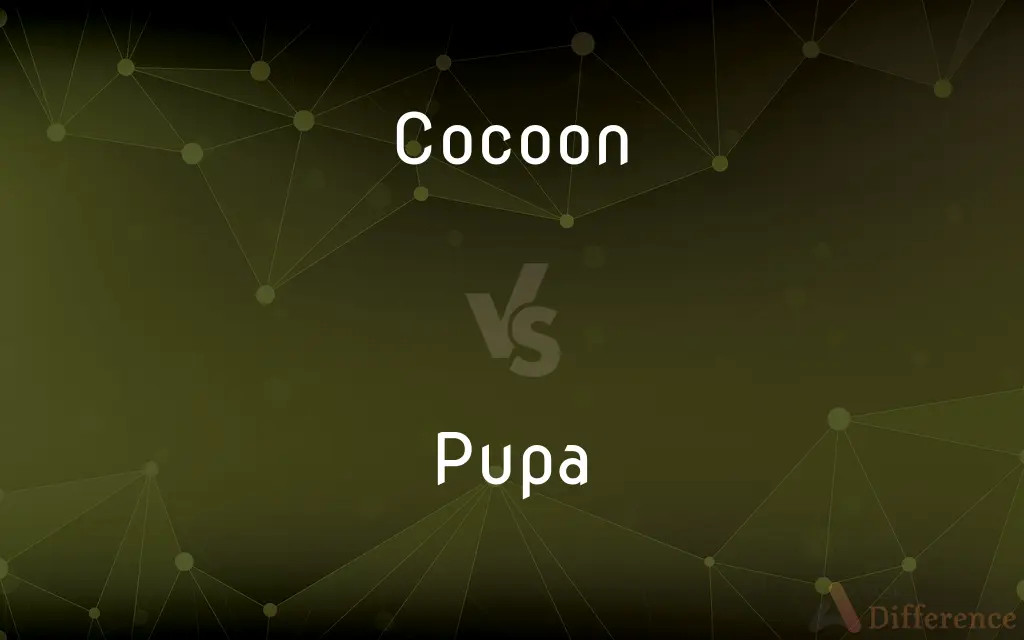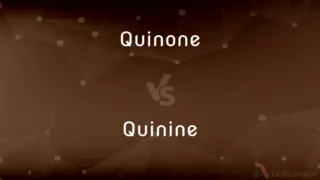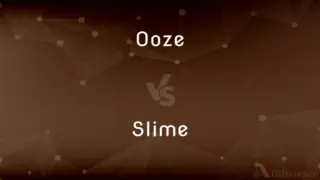Cocoon vs. Pupa — What's the Difference?
Edited by Tayyaba Rehman — By Fiza Rafique — Updated on October 5, 2023
A Cocoon is a protective casing spun from silk, while a Pupa is a developmental stage in some insects, often enclosed within a cocoon.

Difference Between Cocoon and Pupa
Table of Contents
ADVERTISEMENT
Key Differences
A Cocoon is essentially a covering, often silky, that certain insect larvae form for protection during their transition into adulthood. This protective encasement shields the transforming creature, providing a safe environment for the developmental stage known as the Pupa.
The Pupa is not a structure but a phase in the lifecycle of certain insects, where the larva undergoes metamorphosis, turning into an adult. This stage is crucial for transformation, and the organism is enclosed, at times, within structures like the Cocoon, ensuring its safe transition to the next life stage.
While a Cocoon may be generally soft, spun silk, shaped to encase the developing insect, it's significant to note that not all insects create cocoons during their metamorphic stages. In contrast, Pupa refers to a stage where the insect, whether encased in a cocoon or not, undergoes substantial physiological changes, eventually emerging as a mature adult.
In discussing Pupa, it is a developmental stage where various insects like butterflies, moths, and beetles transition from larvae to adults, undergoing significant morphological changes. Conversely, the Cocoon is not a stage but a protective silk covering formed by some insects, like silkworms and some species of moths, to shield the pupa as it transforms.
Through the lens of biology, the Cocoon serves as a physical entity, offering protection and security to the vulnerable, metamorphosing insect. Pupa, however, defines a temporal and biological phase in the insect's life, crucial for its evolution and transition into adulthood.
ADVERTISEMENT
Comparison Chart
Definition
A protective silk covering
A developmental stage in insect metamorphosis
Function
Serves as a protective barrier
Is a phase for biological transformation
Material
Made from silk or other materials
Not a physical structure
Existence
Physical entity
Temporal and biological phase
Universality
Not all pupae create cocoons
Exists in the lifecycle of certain insects
Compare with Definitions
Cocoon
A protective covering for transformation.
The larva secluded itself in a cocoon during metamorphosis.
Pupa
An intermediary stage in metamorphosis.
The butterfly begins to form within the pupa.
Cocoon
A shell within which change occurs.
The moth emerges from its cocoon fully transformed.
Pupa
An inactive stage in the life cycle.
The pupa remains stationary until transformation completes.
Cocoon
A silk encasement for insect metamorphosis.
The caterpillar spins a cocoon before becoming a butterfly.
Pupa
The transformative phase of certain insects.
Within the pupa, drastic biological changes occur.
Cocoon
A safeguard during a vulnerable stage.
The silkworm forms a cocoon during its pupal stage.
Pupa
A stage between larva and adult in insects.
The pupa is immobile and dedicated to internal transformation.
Cocoon
A silky case spun by the larvae of many insects for protection as pupae
The moth emerged from its pale yellow papery cocoon
Pupa
A non-feeding, transformative life stage.
The insect doesn’t eat during its pupa stage.
Cocoon
A covering that prevents the corrosion of metal equipment.
Pupa
A pupa (Latin: pupa, "doll"; plural: pupae) is the life stage of some insects undergoing transformation between immature and mature stages. Insects that go through a pupal stage are holometabolous: they go through four distinct stages in their life cycle, the stages thereof being egg, larva, pupa, and imago.
Cocoon
Envelop in a protective or comforting way
We felt cold even though we were cocooned in our sleeping bags
We remain cocooned in our own little world of fantasies
Pupa
An insect in the nonfeeding stage between the larva and adult, during which it typically undergoes complete transformation within a protective cocoon or hardened case. Only insects that undergo complete metamorphosis have pupal stages.
Cocoon
Spray with a protective coating.
Pupa
An insect in the development stage between larva and adult.
Cocoon
A protective case of silk or similar fibrous material spun by the larvae of moths and certain other insects as a cover for the pupa.
Pupa
Any insect in that stage of its metamorphosis which usually immediately precedes the adult, or imago, stage.
Cocoon
A similar natural protective covering or structure, such as the egg case of a spider.
Pupa
A genus of air-breathing land snails having an elongated spiral shell.
Cocoon
A protective plastic coating that is placed over stored military or naval equipment.
Pupa
An insect in the inactive stage of development (when it is not feeding) intermediate between larva and adult
Cocoon
Something that envelops, protects, or isolates
"a star hidden in a cocoon of dust" (Freeman Dyson). "Actors live in a cocoon of praise. They never meet people who don't like them" (Robert Morley).
Cocoon
To envelop (an insect) in a cocoon.
Cocoon
To wrap in a blanket or other covering.
Cocoon
To cause to be isolated or protected from harsh, dangerous, or disturbing realities; insulate.
Cocoon
To be isolated or protected from harsh, dangerous, or disturbing realities, especially by remaining indoors at home in one's free time.
Cocoon
The silky protective case spun by the larvae of some insects in which they metamorphose, the pupa.
Cocoon
Any similar protective case, whether real or metaphorical.
Cocoon
(transitive) To envelop in a protective case.
Cocoon
(intransitive) To withdraw into such a case.
Cocoon
An oblong case in which the silkworm lies in its chrysalis state. It is formed of threads of silk spun by the worm just before leaving the larval state. From these the silk of commerce is prepared.
Cocoon
The case constructed by any insect to contain its larva or pupa.
Cocoon
Silky envelope spun by the larvae of many insects to protect pupas and by spiders to protect eggs
Cocoon
Retreat as if into a cocoon, as from an unfriendly environment;
Families cocoon around the T.V. set most evenings
She loves to stay at home and cocoon
Cocoon
Wrap in or as if in a cocoon, as for protection
Cocoon
A silky case spun for protection.
Each cocoon harbored a transforming insect inside.
Common Curiosities
What is the purpose of a cocoon?
A cocoon protects the pupa inside from predators, environmental conditions, and other threats as it undergoes metamorphosis.
What is a cocoon?
A cocoon is a protective casing, usually made of silk, spun by many insects for protection during their pupal stage.
What is a pupa?
A pupa is the life stage of some insects undergoing transformation between immature and mature stages.
Why is the pupal stage important?
During this stage, insects undergo metamorphosis, transitioning from larvae (like caterpillars) to their adult form (like butterflies or moths).
How long does the pupal stage last?
The duration varies among species and can range from days to months, depending on environmental conditions and the specific insect.
Is every pupa inside a cocoon?
No. While many moths form cocoons, other insects, like butterflies, develop within exposed pupal casings like chrysalises.
Do all insects make cocoons?
No. Only certain insects, like many moths, create cocoons. Others, like butterflies, form chrysalises.
Are cocoons always silky?
While many are silky, cocoons can vary in texture and material based on the species. Some might incorporate leaves, bark, or other materials.
How is a cocoon made?
It's typically spun from silk produced by the insect, commonly a moth caterpillar, enveloping itself.
Can cocoons be of different colors?
Yes. Cocoon colors can range from white to brown to green, depending on the species and environment.
How can one differentiate between a cocoon and a chrysalis at a glance?
Cocoons often have a wrapped or layered appearance, sometimes incorporating external materials. Chrysalises tend to be smoother and more sculpted to the shape of the developing butterfly inside.
Is a chrysalis the same as a pupa?
A chrysalis is a type of pupa, specifically the protective covering of many butterfly species during their pupal stage.
Can a pupa move?
Generally, pupae are immobile. However, some can wiggle or twitch in response to threats.
How do insects emerge from cocoons or pupal cases?
The transformed insect will release enzymes to soften the cocoon or pupal case and then use physical effort, often with specialized structures, to break free.
Why do some insects form cocoons while others don't?
The choice to form a cocoon or not depends on the species' evolutionary history, environmental pressures, and survival strategies.
Share Your Discovery

Previous Comparison
Quinone vs. Quinine
Next Comparison
Ooze vs. SlimeAuthor Spotlight
Written by
Fiza RafiqueFiza Rafique is a skilled content writer at AskDifference.com, where she meticulously refines and enhances written pieces. Drawing from her vast editorial expertise, Fiza ensures clarity, accuracy, and precision in every article. Passionate about language, she continually seeks to elevate the quality of content for readers worldwide.
Edited by
Tayyaba RehmanTayyaba Rehman is a distinguished writer, currently serving as a primary contributor to askdifference.com. As a researcher in semantics and etymology, Tayyaba's passion for the complexity of languages and their distinctions has found a perfect home on the platform. Tayyaba delves into the intricacies of language, distinguishing between commonly confused words and phrases, thereby providing clarity for readers worldwide.














































